Deportivo Toluca are the latest team to embrace one of Mexican football’s most fascinating phenomena: the regresar, or comeback.
Toluca’s first half of the 2023/24 season in the Apertura was far from ideal. They won just five of their 17 matches (six draws, six losses), scoring 23 goals and conceding 19, to finish 12th out of 18 teams. This led to manager Carlos Morales receiving the sack and the hiring of Renato Paiva.
Under Paiva, Los Escarlatas have found their mojo again, returning to the form they showed last season when they finished second in the Clausura. They have gotten back to that coveted second position on the table with 29 points from 15 matches and are only three points behind leaders Club América.
Toluca are the top scorers in the Clausura with 33 goals, while they also boasted one of the better defences before receiving a 5-0 beatdown from the league leaders last week. Their 21 goals conceded is a concern as the rate is much higher than last season, but much of it has been offset by their excellent attack.
This tactical analysis report will explore the changes in Toluca under Paiva by studying his tactics and analysing key statistics and players, emphasising their offensive explosion.
Background
In Paiva, Toluca have a manager who boasts over 15 years of experience. The Portuguese began his managerial stint with Benfica’s U17 side all the way back in 2007 and stayed there until 2018. Between 2018 and 2020, he managed the Primeira Liga giants’ U19 and B teams before joining Independiente del Valle in January 2021.
Paiva remained in charge of the team for nearly one-and-a-half years, guiding them to a league title. Independiente won 31 of his 60 matches in charge, scoring 98 goals and conceding 65. After departing the Ecuadorian side in May 2022, Paiva was back in a job two months later, joining Club León FC. However, they won only six of his first 18 matches in charge, leading to his exit in November of that year.
In January 2023, Paiva joined EC Bahia and spent nine months there, managing them in 51 matches until November last year. Bahia won 21 of those games and lost 17, with 73 goals scored and 68 conceded.
In January 2024, Toluca appointed Paiva. So far, so good!
What do the stats say about Toluca’s improvement in attack under Paiva?
The stats make for an interesting wrinkle in Toluca’s improvement from the Apertura to the Clausura this season.
As the stat pack below shows, Los Escarlatas are attempting fewer shots and getting a smaller percentage of them on target. However, their shooting from distance has improved in both volume and quality. Additionally, they have become much more potent from counterattacks and are winning more corners, offsetting the drop in the percentage of corners ending in a shot. Their penalty area activity (touches and entries) remains almost the same.
They are also scoring at a much higher rate despite their expected goals (xG), which are marginally dropping, but in a sense, it compensates for their underperformance during the Apertura.
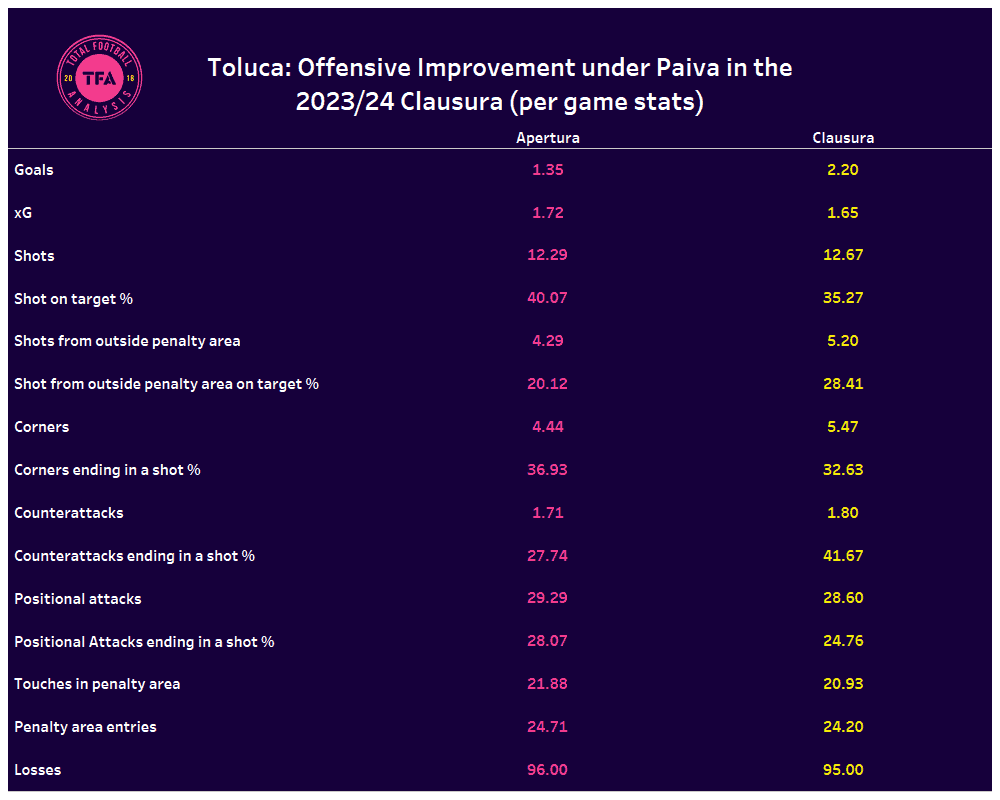
Another interesting aspect of Toluca’s play in the Clausura in comparison to the Apertura is within their passing metrics. As seen below, they are attempting fewer passes despite having more possession, with most of their numbers across the board (passes per possession, forward passes, progressive passes and even back and lateral passes, which are not within this graphic) all falling in volume and accuracy. There is a marginal increase in their volume of final third passes.
However, the biggest change we see is a greater dependence on long balls, with their long-ball attempts taking a massive hike with a limited drop in accuracy. As a result, their average pass length has gone up by more than a yard, while over 10% of their total passes are now long balls compared to 8.4% in the Apertura. They also remain a major threat from crosses, with a decent accuracy rate on nearly 12 attempts per game.
Lastly, they have marginally minimised both their losses (as seen above) and improved in recovering the ball as well.
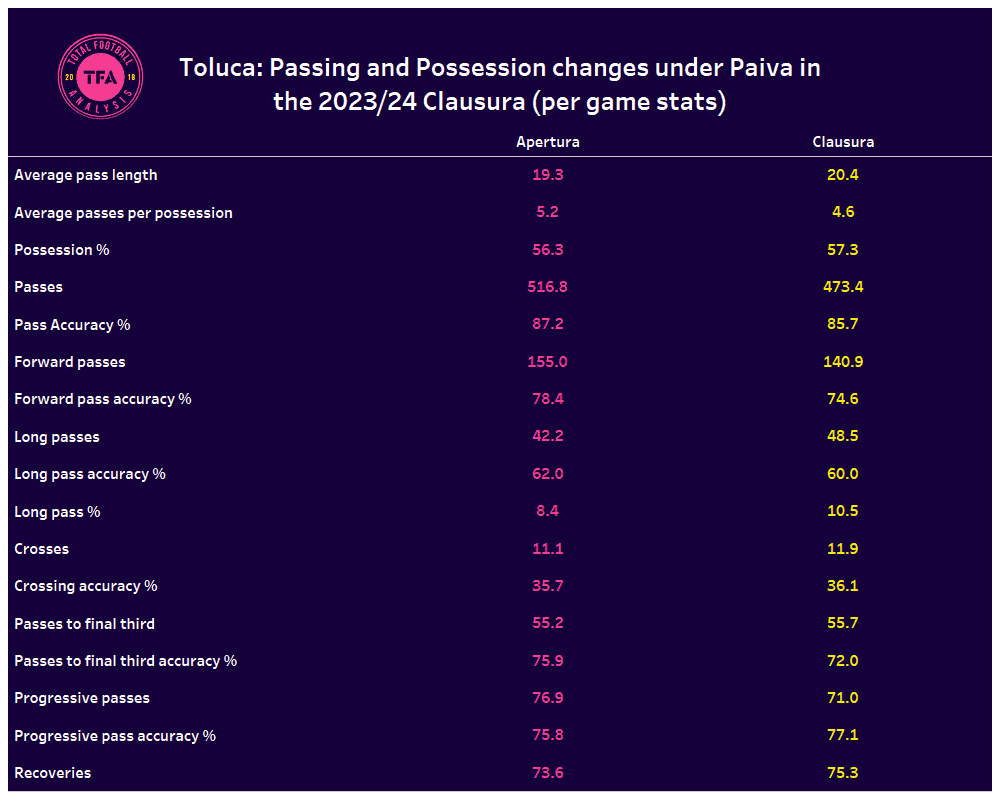
Formations and Personnel
Paiva initially began his tenure at Toluca by adopting a five-at-the-back system, deploying a 5-4-1 in his first two matches. However, he has since shifted to a four-man backline, switching between a 4-4-2 and a 4-2-3-1.
Tiago Volpi has been his preferred goal choice and is, interestingly, their top-scorer in Clausura, with five goals (all penalties). The full-back slots have largely been occupied by Brian García, who can play on either side and right-back Carlos Orrantía. Federico Pereira has been a constant at centre-back, with Juan Escobar partnering him most frequently.
In central/holding midfield, Paiva has often opted for two out of Marcel Ruiz (who can also play further up the pitch), Tomás Belmonte and Claudio Baeza. The wings have been manned by Jean Meneses on the left and Juan Domínguez on the right. Lastly, Alexis Vega has become the preferred centre-forward option, with Jesús Angulo, Iván López or Ruiz playing alongside him in a 4-4-2 and as the 10 in a 4-2-3-1.
Angulo has notably been Paiva’s most-used substitute, coming off the bench eight times, the same as another centre-forward, Robert Morales. The duo are followed by López and Belmonte (seven each), Maximiliano Araújo (six) and Orrantía (five).
Build-up Patterns
As the touch map below shows, much of Toluca’s activity in the attacking half, especially in the final third, is from wide areas. Their build-up often sees them move the ball to either wing through long balls or switches, which we have established as a critical component of their gameplay under Paiva.

This can also be seen in sequences from their matches, such as this one from their 5-1 thrashing of Atlético de San Luis. We initially see just the centre-backs (marked in white) stay back to start the build-up, with the goalkeeper adding an extra passing option. One full-back (white) pushes high and wide, the other stays in the left half-space and the midfielders (black) drop short to receive a pass. A long ball is played over to the left, but the cross is eventually cleared.

In the second phase, the centre-backs once again initiate the play while the midfielders and forwards occupy gaps between the opposition’s defensive lines. This time, they go to the right-wing rather than the left.

In these two sequences, Toluca focuses on stretching their opponents out by placing bodies in midfield and then spreading their full-backs or wingers out wide to open passing lanes. However, they have also shown that they can get through opponents who mark tighter through intricate passing, as they do in this sequence from their match against Atlas.
Here, due to Atlas’ pressers, a midfielder drops back to assist with the build-up and exchanges a quick pass with the right back to get the ball back and move into space.

This versatility has been a critical driver of Toluca’s improvement in offence. While they remain a team that uses switches, long balls and crosses at high volumes, they also have the potential to get through the press with pass-and-move plays.
Modes of Attack
Crosses
As mentioned earlier, Toluca has extensively utilised crosses for their goals. Their reasonable accuracy in these situations and ability to deliver menacing crosses from both flanks help them stretch opposition backlines and enable their forwards to find spaces in the box.
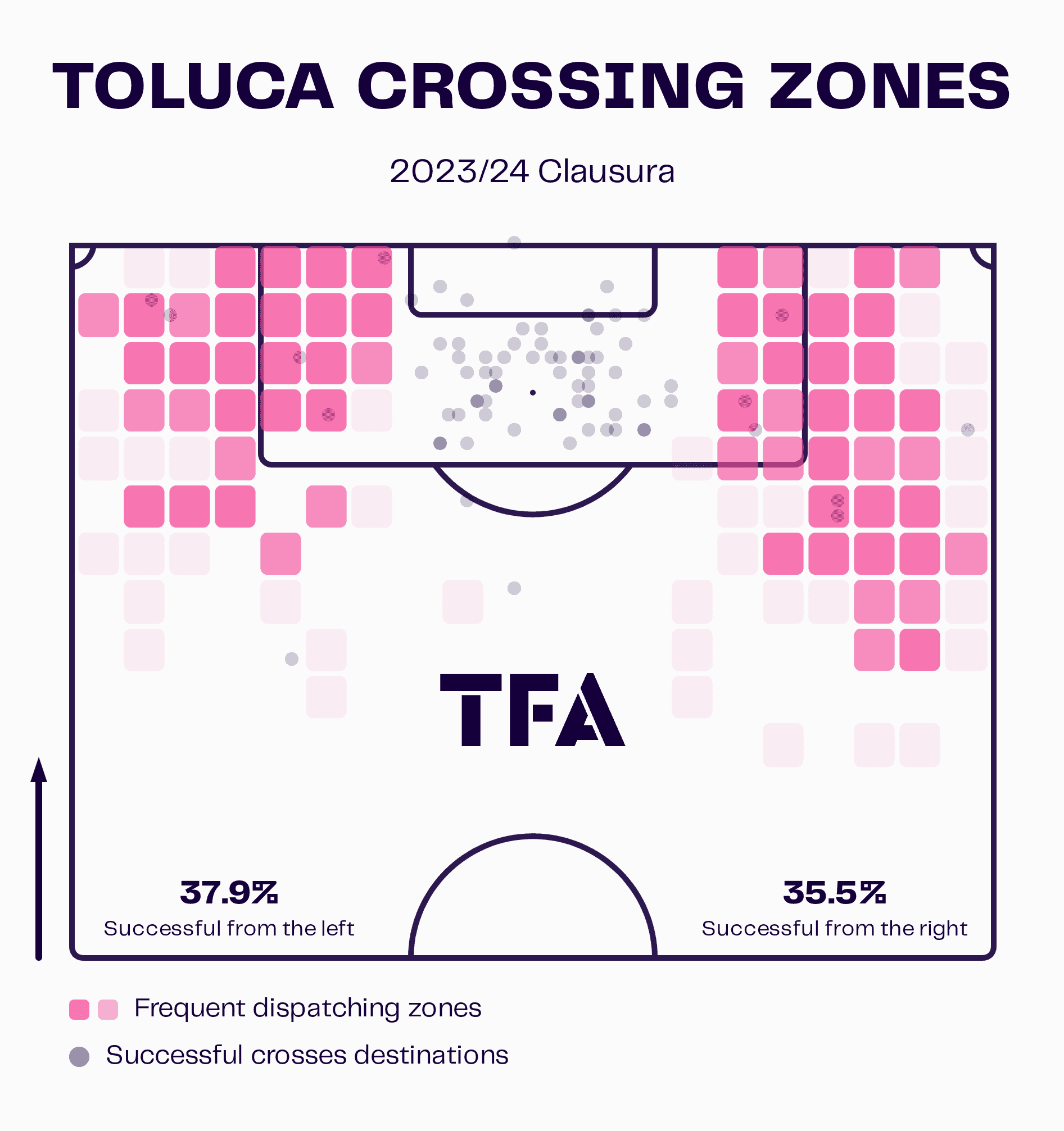
Their joint top-scorer this season is Vega, who has five goals and is a solid threat from crosses. In the sequence below from their match against Atlas, his excellent movement allows him to charge into space between two defenders and score with a header. The play initially originates from a switch to the left.
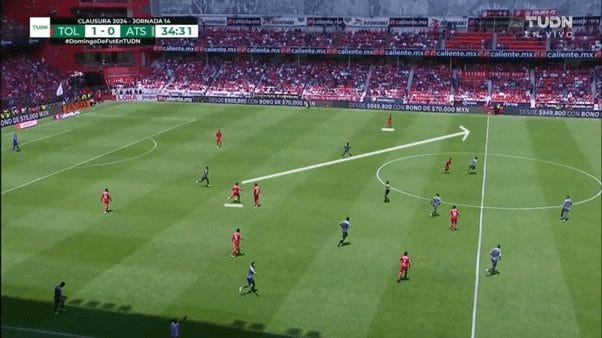
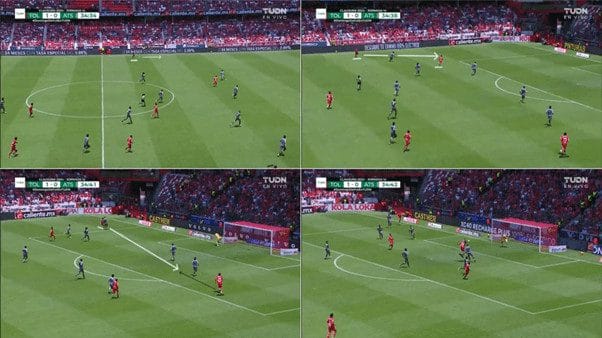
Meneses notably assisted this goal, and his crossing has been a significant factor in Toluca’s offence. Another excellent example of his crossing ability came in their match against Necaxa, where he set up Belmonte with a first-time cross after a quick pass exchange.
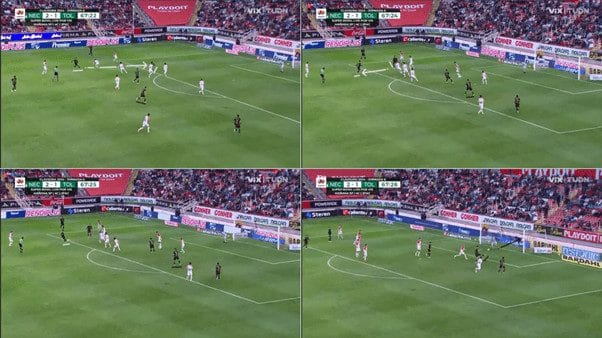
Toluca’s primary crossing outlet from the other flank has been Orrantía, and in the sequence below against Club Tijuana, he sets up Meneses with a superb cutback into the box. The move is initiated once again by a centre-back, who breaks two lines to find the right-back racing down his wing. The pass unsettles the defence, who try to scramble back but cannot track Meneses, who is open and scores from unmissable range.
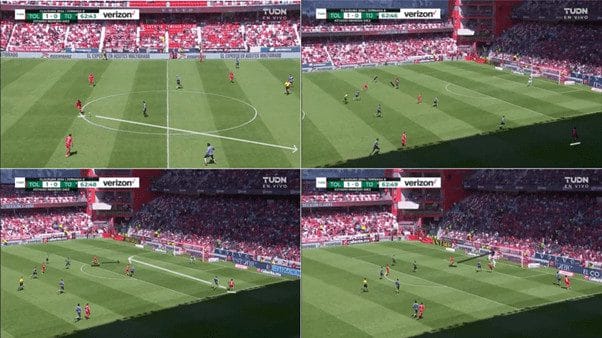
Corners
Given their crossing proficiency, it comes as no surprise that Toluca have been excellent from corners. Los Escarlatas have used a variety of corner-takers this term, with Angulo, Vega, Ruiz and Belmonte all getting a crack at it.
Their typical approach from corners sees two players wait at the edge of the box, a runner who aims to get a flick-on position at the near post, and one player who peels off from the middle to get to the far post. This gives them two men at the near post, three to four around the penalty spot, and one at the back post.
The sequence below from their match against FC Juárez shows all of these. In this example, Angulo takes the corner.
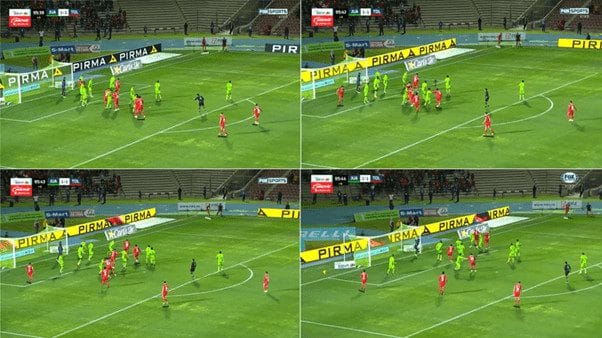
When it comes together, it looks something like this goal by Pereira against León. A corner to a central area is flicked onto the far post, where Pereira gets a header away. The goalkeeper brilliantly saves it, but it comes back out to the centre-back, and he finds the back of the net.
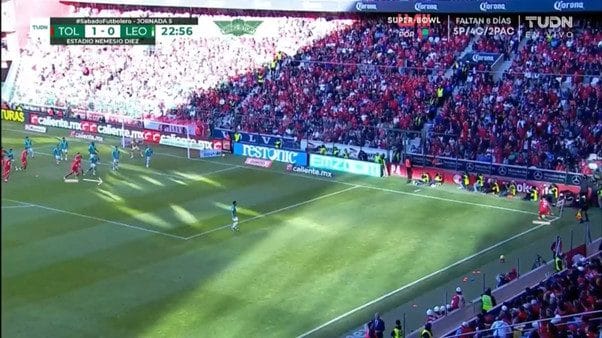
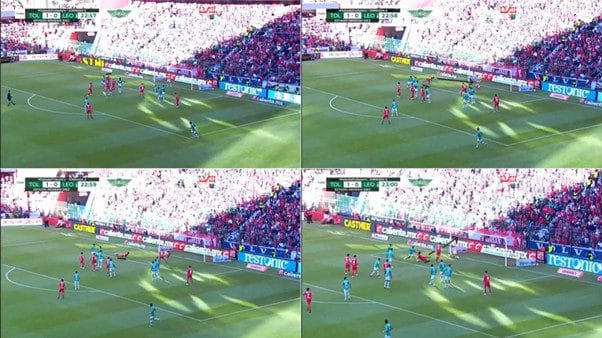
Penalties
In goalkeeper Volpi, Toluca have an excellent penalty-taker. He has taken 15 penalties for the club since joining in July 2022 and has scored all of them. Five of those have come in this season’s Clausura, making him the joint top-scorer for the team alongside Vega.
Volpi, as you would expect from goalkeepers, has plenty of power in his feet. However, What stands out is his control and the variety he has in his locker. Consider the following goal against UNAM Pumas: he takes multiple small steps, a stride to get into his kicking motion, and then slams the ball with his right into the top-left corner as the goalkeeper dives the other way.
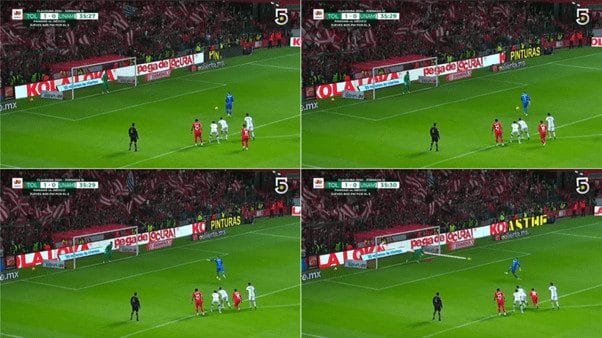
In contrast, Volpi takes just one step before blasting the ball home from the penalty spot against Tigres.
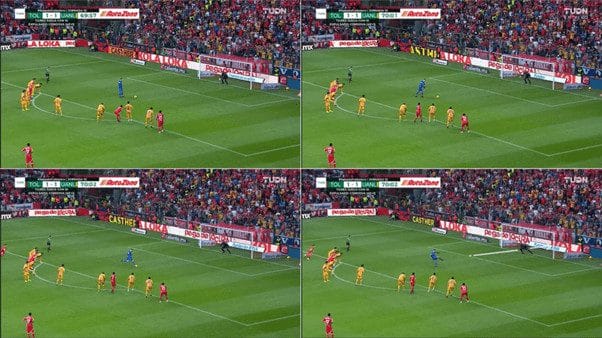
Counterattacks
The final component of Toluca’s rounded-out attack is their improved efficiency on the counter. Under Paiva, they have marginally increased their counters per game from 1.71 in this season’s Apertura to 1.80 in the Clausura, but the bigger difference is the percentage of these ending in a shot (27.74% vs 41.67%).
Los Escarlatas have pace and willing runners on the team and an intuition for the chance to counter. In the sequence below from their win over San Luis, we see a few of the Toluca defenders already begin running towards the opposition half as the corner is floated in. The players defending in the box instantly turn away from their own goal once the ball is initially cleared, which sets them up for a quick break and eventually results in a goal scored by Meneses after rounding the goalkeeper.
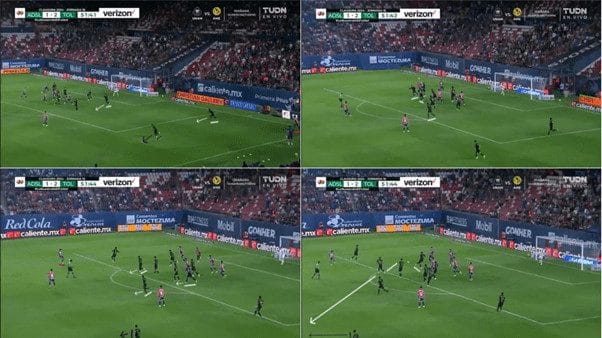
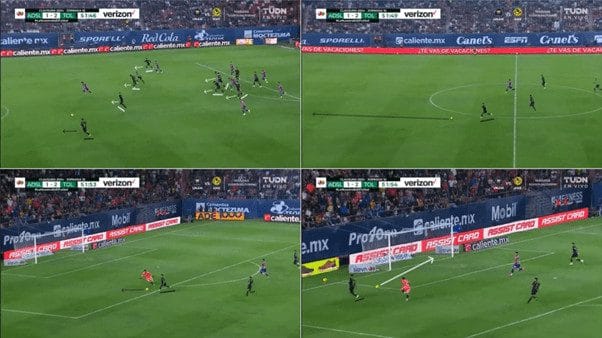
Toluca’s players have also shown a similar level of ruthlessness on the counter in an open-play situation. In the clip below from their match against Mazatlán, they win the ball in midfield and release it down the right wing. An inviting ball across the box comes in, and Meneses has the easy job of tapping it in at the far post.
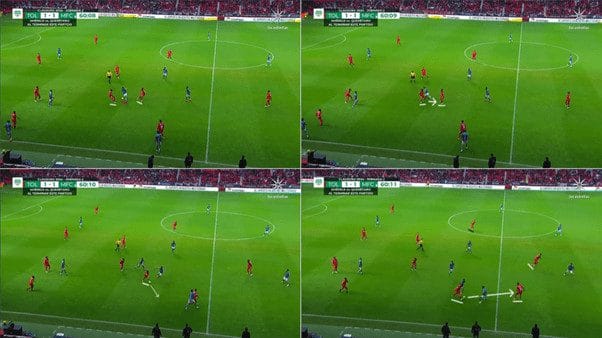
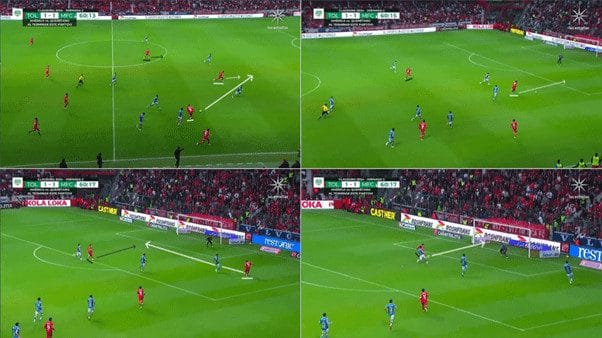
It is worth noting that these are very early stages in Toluca’s development as a counter-attacking team. With more games under their belts, Paiva’s men could become even more dangerous on the break, which will be a warning sign for opponents given that Toluca can already trouble them on multiple levels.
Conclusion
Overall, Toluca’s latest rendition is an incredibly exciting one. Paiva deserves immense credit for not only improving their existing modes of attack but also introducing new aspects that have helped them stage a title fight and contend for their first major title since they won the Clausura in 2010.
It will not be easy, with Club America posing a stiff challenge. Once the tournament enters knockouts, a few surprises could also be in the offing. However, Paiva has got them clicking like they rarely have in the past few years, and this could very well be the season they rediscover what led them to major titles earlier this century.





Comments